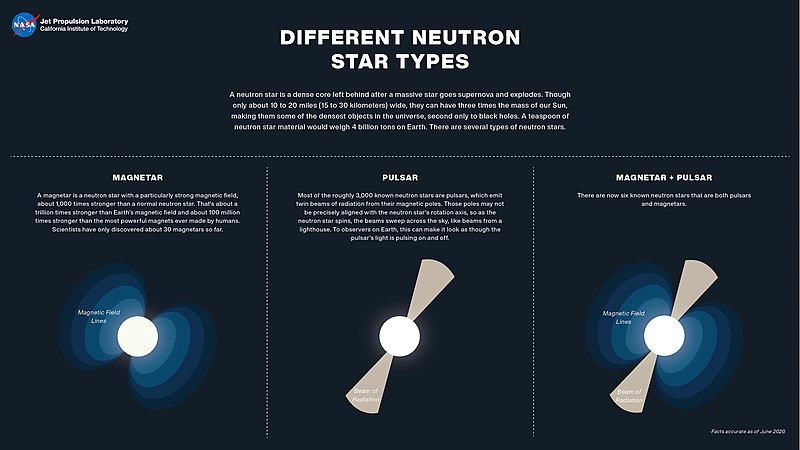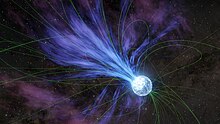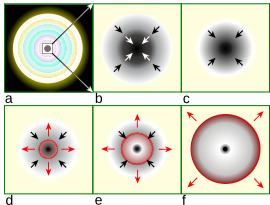
A neutron star is the collapsed core of a massive supergiant star. The stars that later collapse into neutron stars have a total mass of between 10 and 25 solar masses (M☉), possibly more if the star was especially rich in elements heavier than hydrogen and helium. Except for black holes, neutron stars are the smallest and densest known class of stellar objects. Neutron stars have a radius on the order of 10 kilometers (6 mi) and a mass of about 1.4 M☉. They result from the supernova explosion of a massive star, combined with gravitational collapse, that compresses the core past white dwarf star density to that of atomic nuclei.
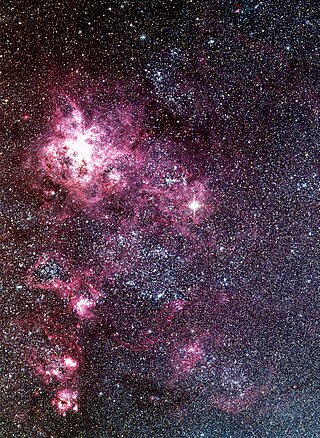
SN 1987A was a type II supernova in the Large Magellanic Cloud, a dwarf satellite galaxy of the Milky Way. It occurred approximately 51.4 kiloparsecs from Earth and was the closest observed supernova since Kepler's Supernova in 1604. Light and neutrinos from the explosion reached Earth on February 23, 1987 and was designated "SN 1987A" as the first supernova discovered that year. Its brightness peaked in May of that year, with an apparent magnitude of about 3.

In gamma-ray astronomy, gamma-ray bursts (GRBs) are immensely energetic explosions that have been observed in distant galaxies, described by NASA as "the most powerful class of explosions in the universe". They are the most energetic and luminous electromagnetic events since the Big Bang. Bursts can last from ten milliseconds to several hours. After an initial flash of gamma rays, a longer-lived "afterglow" is usually emitted at longer wavelengths.

The Crab Nebula is a supernova remnant and pulsar wind nebula in the constellation of Taurus. The common name comes from a drawing that somewhat resembled a crab with arms produced by William Parsons, 3rd Earl of Rosse, in 1842 or 1843 using a 36-inch (91 cm) telescope. The nebula was discovered by English astronomer John Bevis in 1731. It corresponds with a bright supernova recorded by Chinese astronomers in 1054 as a guest star. The nebula was the first astronomical object identified that corresponds with a historically-observed supernova explosion.
A soft gamma repeater (SGR) is an astronomical object which emits large bursts of gamma-rays and X-rays at irregular intervals. It is conjectured that they are a type of magnetar or, alternatively, neutron stars with fossil disks around them.
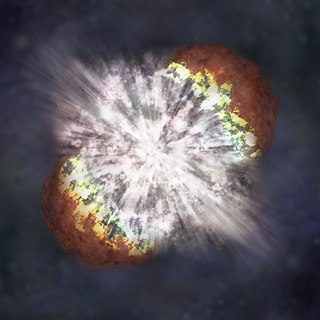
A super-luminous supernova is a type of stellar explosion with a luminosity 10 or more times higher than that of standard supernovae. Like supernovae, SLSNe seem to be produced by several mechanisms, which is readily revealed by their light-curves and spectra. There are multiple models for what conditions may produce an SLSN, including core collapse in particularly massive stars, millisecond magnetars, interaction with circumstellar material, or pair-instability supernovae.
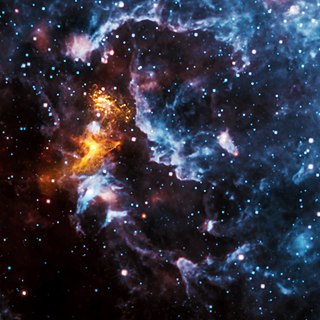
A pulsar is a highly magnetized rotating neutron star that emits beams of electromagnetic radiation out of its magnetic poles. This radiation can be observed only when a beam of emission is pointing toward Earth, and is responsible for the pulsed appearance of emission. Neutron stars are very dense and have short, regular rotational periods. This produces a very precise interval between pulses that ranges from milliseconds to seconds for an individual pulsar. Pulsars are one of the candidates for the source of ultra-high-energy cosmic rays.

SGR 1806−20 is a magnetar, a type of neutron star with a very powerful magnetic field, that was discovered in 1979 and identified as a soft gamma repeater. SGR 1806−20 is located about 13 kiloparsecs (42,000 light-years) from Earth on the far side of the Milky Way in the constellation of Sagittarius. It has a diameter of no more than 20 kilometres (12 mi) and rotates on its axis every 7.5 seconds (30,000 kilometres per hour (19,000 mph) rotation speed at the surface). As of 2016, SGR 1806-20 is the most highly magnetized object ever observed, with a magnetic field over 1015 gauss (G) (1011 tesla) in intensity (compared to the Sun's 1–5 G and Earth's 0.25–0.65 G).
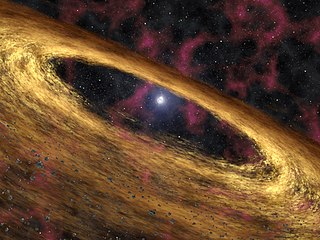
4U 0142+61 is a magnetar at an approximate distance of 13000 light-years from Earth, located in the constellation Cassiopeia.

A radio-quiet neutron star is a neutron star that does not seem to emit radio emissions, but is still visible to Earth through electromagnetic radiation at other parts of the spectrum, particularly X-rays and gamma rays.

Shrinivas Ramchandra Kulkarni is a US-based astronomer born and raised in India. He is currently a professor of astronomy and planetary science at California Institute of Technology, and he served as director of Caltech Optical Observatory (COO) at California Institute of Technology, in which capacity he oversaw the Palomar and Keck among other telescopes. He is the recipient of a number of awards and honours.
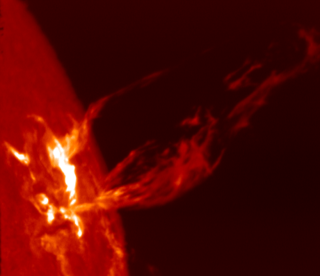
A stellar magnetic field is a magnetic field generated by the motion of conductive plasma inside a star. This motion is created through convection, which is a form of energy transport involving the physical movement of material. A localized magnetic field exerts a force on the plasma, effectively increasing the pressure without a comparable gain in density. As a result, the magnetized region rises relative to the remainder of the plasma, until it reaches the star's photosphere. This creates starspots on the surface, and the related phenomenon of coronal loops.

Gamma-ray burst progenitors are the types of celestial objects that can emit gamma-ray bursts (GRBs). GRBs show an extraordinary degree of diversity. They can last anywhere from a fraction of a second to many minutes. Bursts could have a single profile or oscillate wildly up and down in intensity, and their spectra are highly variable unlike other objects in space. The near complete lack of observational constraint led to a profusion of theories, including evaporating black holes, magnetic flares on white dwarfs, accretion of matter onto neutron stars, antimatter accretion, supernovae, hypernovae, and rapid extraction of rotational energy from supermassive black holes, among others.
SGR 0526−66 is a soft gamma repeater (SGR), located in the Super-Nova Remnant (SNR) 0526−66.1, otherwise known as N49, in the Large Magellanic Cloud. It was the first soft gamma repeater discovered, and as of 2015, the only known located outside our galaxy. First detected in March 1979, it was located by using the measurement of the arrival time differences of the signal by the set of artificial satellites equipped with gamma ray detectors. The association with N49 can only be indirect: it seems clear that soft gamma repeaters form in young stellar clusters. It is not certain that the explosion that gave birth to SGR 0525-66 is also the one that produced the remnant N49.
SGR 1627−41, is a soft gamma repeater (SGR), located in the constellation of Ara. It was discovered June 15, 1998 using the Burst and transient Source Experiment (BATSE) and was the first soft gamma repeater to be discovered since 1979. During a period of 6 weeks, the star bursted approximately 100 times, and then went quiet. The measured bursts lasted an average of 100 milliseconds, but ranged from 25 ms to 1.8 seconds. SGR 1627−41 is a persistent X-ray source. It is located at a distance of 11 kpc in the radio complex CTB 33, a star forming region that includes the supernova remnant G337.0-0.1.

Astrophysical X-ray sources are astronomical objects with physical properties which result in the emission of X-rays.

GRB 101225A, also known as the "Christmas burst", was a cosmic explosion first detected by NASA's Swift observatory on Christmas Day 2010. The gamma-ray emission lasted at least 28 minutes, which is unusually long. Follow-up observations of the burst's afterglow by the Hubble Space Telescope and ground-based observatories were unable to determine the object's distance using spectroscopic methods.

Fiona A. Harrison is the Kent and Joyce Kresa Leadership Chair of the Division of Physics, Mathematics and Astronomy at Caltech, Harold A. Rosen Professor of Physics at Caltech and the Principal Investigator for NASA's Nuclear Spectroscopic Telescope Array (NuSTAR) mission. She won the Hans A. Bethe Prize in 2020 for her work on NuSTAR.

A hypernova is a very energetic supernova which is believed to result from an extreme core-collapse scenario. In this case, a massive star collapses to form a rotating black hole emitting twin astrophysical jets and surrounded by an accretion disk. It is a type of stellar explosion that ejects material with an unusually high kinetic energy, an order of magnitude higher than most supernovae, with a luminosity at least 10 times greater. Hypernovae release so much of gamma rays they usually appear similar to a type Ic supernova, but with unusually broad spectral lines indicating an extremely high expansion velocity. Hypernovae are one of the mechanisms for producing long gamma ray bursts (GRBs), which range from 2 seconds to over a minute in duration. They have also been referred to as superluminous supernovae, though that classification also includes other types of extremely luminous stellar explosions that have different origins.

Imaging X-ray Polarimetry Explorer, commonly known as IXPE or SMEX-14, is a space observatory with three identical telescopes designed to measure the polarization of cosmic X-rays of black holes, neutron stars, and pulsars. The observatory, which was launched on 9 December 2021, is an international collaboration between NASA and the Italian Space Agency (ASI). It is part of NASA's Explorers program, which designs low-cost spacecraft to study heliophysics and astrophysics.


